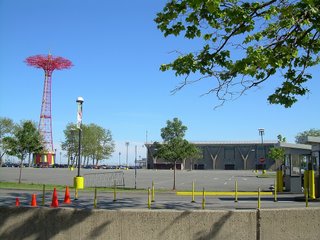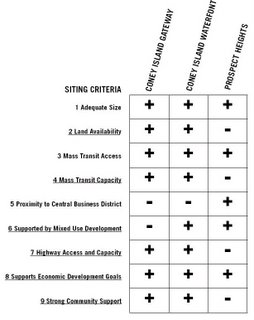 There was something fishy about Borough President Marty Markowitz's rapid disavowal, in 2003, of his longstanding support for an arena in Coney Island. After all, as Brian Hatch and I
There was something fishy about Borough President Marty Markowitz's rapid disavowal, in 2003, of his longstanding support for an arena in Coney Island. After all, as Brian Hatch and Ihave pointed out, there are strong arguments--transportation capacity, neighborhood revitalization--for an arena in Coney.
And, as I noted, there's something fishy about the quick dismissal of Coney in the Draft Environmental Impact Statement (DEIS) issued by the Empire State Development Corporation (ESDC).
However, as a study (Report on Three Decades of Locational Analysis for a Brooklyn Arena) from urban planner Simon Bertrang on behalf of Develop Don't Destroy Brooklyn shows, the ESDC's failure is much worse. The agency, while relying on a 1974 study that seems to point to Prospect Heights as the only remaining arena site, omits any mention of later studies, in 1984 and 1994, both of which preferred sites in Coney Island.
And, as Bertrang shows in the graphical renderings reproduced here, the arena could fit on available sites.
Executive summary
 Bertrang's executive summary deserves quotation in full:
Bertrang's executive summary deserves quotation in full:The siting criteria and analysis for the proposed basketball arena in Prospect Heights are summarily dealt with in three pages in Chapter 1 of the DEIS. The major source of information is a preliminary study three decades out of date. The DEIS does not include a comprehensive comparison of potential arena sites in Brooklyn and does not engage in a convincing site survey and feasibility analysis for any site. The location of a sports arena for Brooklyn has been studied repeatedly over the last few decades - and yet the DEIS fails to identify those studies and ignores their results, choosing to focus on the Prospect Heights location to the detriment of a sound economic development and planning process for Brooklyn.
After reading the 1974 study and the successive studies on arena locations in 1984 and 1994, we looked at the current status of the sites identified. Based on the siting criteria proposed in the DEIS and the 1984 locational analysis, we find that the preferred location for an arena remains Coney Island. ESDC must examine Coney Island and other potential Brooklyn arena locations as viable alternatives to a Prospect Heights arena. ESDC and the people of Brooklyn need a clear comparative analysis of appropriate alternatives in order to develop an authoritative conclusion as to the best location for a Brooklyn arena.
There is NO evidence or argument made in the DEIS as to why an arena should be located at FCRC/ESDC’s chosen Prospect Heights location or why a proposed Brooklyn arena must be developed in conjunction with a major residential development. ESDC has made a gross error by ignoring the results of the 1984 and 1994 studies that found Coney Island to be the best site in the borough for a multi-use arena.
It's a historical gap even worse than the failure in the DEIS to acknowledge the role of historic preservation in reviving the neighborhoods around the proposed Atlantic Yards site.
Looking back
 The 1974 report by the City of New York, titled Preliminary Study of Feasibility: Brooklyn Sports Complex, does not establish siting criteria, Bertrang notes. (The DEIS does dismiss the other potential sites as unavailable, but as I noted, the construction of KeySpan park--and thus the loss of the preferred Coney Island site--didn't deter Markowitz and others from focusing on a site next door, shown at right, with Abe Stark rink in the background.)
The 1974 report by the City of New York, titled Preliminary Study of Feasibility: Brooklyn Sports Complex, does not establish siting criteria, Bertrang notes. (The DEIS does dismiss the other potential sites as unavailable, but as I noted, the construction of KeySpan park--and thus the loss of the preferred Coney Island site--didn't deter Markowitz and others from focusing on a site next door, shown at right, with Abe Stark rink in the background.)The ESDC can't say it didn't know about the 1984 report, titled The Brooklyn Sports Study: Phase 1 Locational Analysis; the agency's predecessor commissioned it. Bertrang writes:
Ten years later, the Pratt Institute Center for Community and Environmental Development picked up where the City left off. It conducts a similar survey of sites, this time eleven instead of ten. Four of these sites, Coney Island, Broadway Junction, Atlantic Terminal and Brooklyn Army Terminal, are the same ones considered by the City in 1974. The report was prepared by Pratt Institute for the New York State Urban Development Corporation, the same entity undertaking the current study and proposal (In or about 1995, UDC changed its operating name to ESDC).
While the earlier study touched on a demographic analysis, an analysis of transportation networks and the existing conditions of the sites, the 1984 report concluded that two Coney Island sites were best, based on a set of site selection criteria.
Some of those site selection criteria have also been used in the DEIS--size, transit/highway access, and proximity to existing infrastructure--but others have not, such as reinforcing the economic vitality of the surrounding community, should be located mostly on vacant/available land, and should be in a community supportive of the proposed arena.
In 1994, the Brooklyn Sports Foundation and the Temporary State Commission on Brooklyn Recreational Facilities commissioned the Brooklyn Sportsplex Development Plan to evaluate a project on the site of the former Steeplechase Park.
(This was not a full study, rather a closer look at one of the two preferred sites from a decade earlier.)
The Coney sites
 While Bertrang shows that an arena could fit on the "Gateway site" owned by KeySpan Energy, within walking distance of the Coney Island terminus, that site isn't so attractive today. Not only would it require a pedestrian bridge over Coney Island Creek, the arena would be isolated--a mini-Meadowlands in Brooklyn--rather than part of the urban fabric.
While Bertrang shows that an arena could fit on the "Gateway site" owned by KeySpan Energy, within walking distance of the Coney Island terminus, that site isn't so attractive today. Not only would it require a pedestrian bridge over Coney Island Creek, the arena would be isolated--a mini-Meadowlands in Brooklyn--rather than part of the urban fabric.More feasible would be the "Waterfront site," which retains space for an arena, either in the parking lot of Abe Stark Rink just west of KeySpan Park, or using a footprint slightly to the west, assuming the acquisition of adjacent privately-owned and underutilized parcels. (Also, the rink, which opened in 1970, could be razed.)
Siting criteria
 The chart here deserves some footnotes. While Bertrang notes that the Prospect Heights location lacks land availability, that's because several property owners are unwilling to sell to Forest City Ratner, and some will sue to block eminent domain. He adds:
The chart here deserves some footnotes. While Bertrang notes that the Prospect Heights location lacks land availability, that's because several property owners are unwilling to sell to Forest City Ratner, and some will sue to block eminent domain. He adds:In addition, the proposed Prospect Heights site requires the demapping of two city streets and the relocation of the Vanderbilt Avenue railyard at considerable public expense.
The question of community support isn't simple. There is significant opposition to the project in Prospect Heights. While Coney Island leaders, including City Council Member Dominic Recchia, have expressed support for an arena in Coney, Recchia has also endorsed the Atlantic Yards plan.
Key difference
Still, there's a glaring difference between the mass transit capacity at Coney Island--where trains can be positioned at the end of the line to quickly load crowds--and that at the busy but already crowded hub at Atlantic Terminal. Bertrang writes:
The Coney Island subway lines have low existing passenger loads and substantial reserve capacities. In addition, the Stillwell Avenue station is a newly renovated jewel – with wide ramps and platforms designed to handle a surge in crowds and efficient vertical movement from platform to street.
 The Atlantic Avenue/Pacific Street station on the other hand has no reserve capacity – the platforms and trains are overcrowded, the platforms narrow and the maze of underground corridors connecting the various platforms confusing. If mass transit’s capacity to absorb new riders, especially the kind of surge in riders associated with the beginning or end of an NBA game in New York City, is taken into account, the Coney Island sites are far superior.
The Atlantic Avenue/Pacific Street station on the other hand has no reserve capacity – the platforms and trains are overcrowded, the platforms narrow and the maze of underground corridors connecting the various platforms confusing. If mass transit’s capacity to absorb new riders, especially the kind of surge in riders associated with the beginning or end of an NBA game in New York City, is taken into account, the Coney Island sites are far superior. What about proximity to a Central Business District? Bertrang calls that criterion the "least convincing" one in the DEIS, noting that a mixed-use development need not include offices but could, in Coney, be part of an entertainment district. (Note that an arena next to KeySpan Park, above, would be even closer to the subway than at the Gateway site.)
Indeed, as I wrote, Forest City Ratner earlier said the project couldn't be built in Coney Island because of the need to build office space near a downtown transit hub. However, the developer initially projected about 2 million square feet of office space and 10,000 office jobs; now the office space has been cut by more than two-thirds, and the job projection by three-quarters.
Bertrang writes:
The City’s new vision for Coney Island is a year round entertainment district with exactly the kind of “strong mix of urban land uses” that ESDC prefers for an arena location.
Moreover, an arena in Coney Island would help revitalize the area--indeed, the neighborhood still awaits major investment and refurbishing or replacement of vast public housing complexes.
Bertrang suggests redevelopment in Prospect Heights "with appropriately scaled development" would be appropriate and welcomed. He adds:
However, nothing in the economic development goals of the Prospect Heights neighborhood necessitates an arena - in fact, an arena may be a drag on the project – creating an infrastructure headache, requiring the expensive relocation of the rail yards, and necessitating the use of eminent domain and the delays associated with its application.
Unmentioned here, or in the DEIS, is one of the main reasons for the arena: to leverage state and city funds, and political support, for a much larger development project. As the Slatin Report last month quoted a pro-development city official:
The arena, the official complained, is a "Trojan Horse" that the developer used to sneak an overly dense project into Brooklyn.
More criteria
As previously noted, an analysis by Michael Sorkin compared the proposed West Side Stadium site to other sites, and Coney Island, among some other sites, was judged superior. While a stadium is not an arena, many of the arguments apply, and the Prospect Heights site falls short.

Comments
Post a Comment